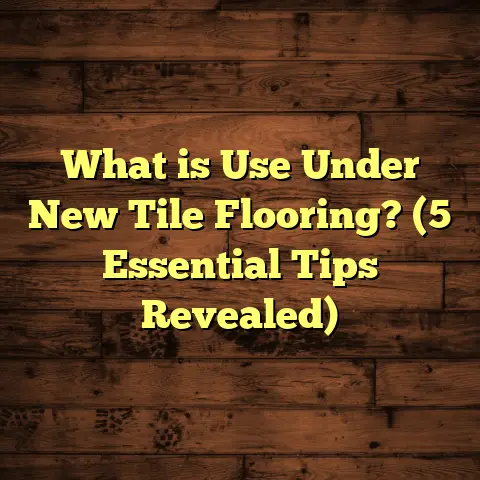What is Installing Floors vs. Baseboards? (3 Key Tips Inside!)
I like to think of installing floors and baseboards as setting the stage for a home’s story. Imagine the floor as the solid foundation of your narrative, the broad canvas where everything else happens. Then, the baseboards act like the frame around that canvas, tying the story together with neat, finished edges. Both are essential, but they serve different roles in creating a polished look.
What is Installing Floors vs. Baseboards?
Let’s clear up exactly what these two tasks mean because they’re often talked about together but are quite distinct.
Installing floors means putting down the surface you walk on—whether it’s hardwood, laminate, vinyl, tile, or carpet. This involves preparing the subfloor, measuring, cutting, fitting, and securing the chosen material so it’s stable and looks great.
On the other hand, installing baseboards is about adding those strips of trim along the bottom edge of walls where they meet the floor. Baseboards cover gaps between flooring and walls, protect walls from kicks and scuffs, and add that final decorative touch to complete a room’s look.
They’re connected because one usually follows the other—first you put in the floors, then you add the baseboards to finish things off. But they require different skills, tools, and attention.
My Personal Experience: Floors and Baseboards Are a Team Effort
I’ve worked on many projects where clients ask if floors and baseboards are “the same thing.” It’s a common mix-up! Early in my career, I learned firsthand why separating these jobs matters.
One time, I installed a beautiful oak hardwood floor in a client’s living room. We meticulously laid down every plank, making sure each one fit perfectly with tight seams. When I started adding baseboards, I realized the wall wasn’t entirely even—there were slight bumps and dips. So, I had to carefully scribe the baseboards to match those contours. That step took patience but made all the difference in giving the room a crisp, professional finish.
This taught me that floors set the tone for a room’s durability and feel, while baseboards refine its look and protect it from everyday wear. Both deserve attention but require different approaches.
Breaking Down Floors: What Goes Into Installing Them?
Subfloor Preparation
Before you lay any type of flooring down, you need a strong foundation underneath—the subfloor. This is usually plywood or concrete depending on your home’s structure.
I can’t stress enough how crucial this step is. On one project, we skipped leveling the subfloor properly to save time. Months later, the laminate planks started popping up because of uneven support underneath. Lesson learned: take time here or pay for it later.
Material Acclimation
Hardwood flooring especially needs to “get used” to your home’s temperature and humidity levels before installation. I always recommend leaving hardwoods in the room for at least 3-5 days before starting. This prevents unwanted warping or gaps after installation.
Laminate and vinyl tend to be less sensitive but still appreciate some acclimation if possible.
Measuring & Layout Planning
This is part science, part art. You want to create a layout that minimizes awkward cuts or thin strips near walls—which can look unprofessional.
For example, when I installed engineered hardwood in a narrow hallway once,
I adjusted the layout to run planks lengthwise with staggered joints,
which helped hide seams and gave a natural flow visually.
Installation Methods
Floors can be installed in various ways:
- Nail-down: Typical for solid hardwood on wooden subfloors.
- Glue-down: Used often for vinyl tiles or engineered hardwood over concrete.
- Floating: Popular for laminate or some engineered woods where planks click together without glue or nails.
- Peel-and-stick: Vinyl sheets or tiles might use this simpler method for DIY projects.
Each method requires specific tools and know-how.
Finishing Touches
Some floors need sanding and sealing after installation (especially raw hardwood), while others come prefinished.
I always tell clients: investing in quality finishing products protects your floor from stains or scratches for years.
Baseboards: More Than Just a Pretty Border
After floors are down, baseboards come into play—not just as decoration but as protection and cover-up.
Covering Gaps & Imperfections
Walls aren’t perfectly straight; floors expand and contract. Baseboards hide these inevitable gaps that would otherwise look messy.
Wall Protection
Think about all the times feet kick walls or furniture brushes against them.
Baseboards absorb some of this damage, saving your painted walls from chips and dents.
Style Statement
Beyond function, baseboards add character. From simple modern trims to ornate Victorian profiles,
they help define a room’s style. Sometimes changing baseboards transforms a room entirely.
Why Ignoring One or Both Can Cost You
In my years working with homeowners and contractors,
I’ve seen how neglecting either floors or baseboards leads to problems:
- Floors installed too close to walls without expansion space buckling under pressure.
- Baseboards nailed too tightly against floors causing squeaks or cracks.
- Gaps left uncovered by baseboards collecting dust or insects.
- Poorly matched styles making rooms look unfinished or awkward.
Fixing these often involves ripping out parts of your floor or trim—a costly and frustrating ordeal.
3 Key Tips I’ve Learned About Floors and Baseboards
Here are three practical tips that have saved me time and headaches on countless jobs.
Tip 1: Always Leave Expansion Gaps When Installing Floors
Wood and laminate floors expand and contract with humidity changes—especially in climates with big seasonal swings.
On one winter project in Minnesota,
ignoring expansion gaps caused hardwood floors to buckle badly when spring humidity hit.
Leaving about 1/4 inch (6 mm) around all walls lets floors move naturally without damage. The baseboards then cover this gap neatly—win-win!
Tip 2: Use Coping Cuts for Inside Corners on Baseboards
Miter cuts alone often don’t fit perfectly on inside corners due to uneven walls.
Using a coping saw to shape one board’s edge so it fits over the other creates tight joints that look professionally done.
This technique takes practice but makes a huge difference in appearance.
Tip 3: Order Extra Material for Waste and Mistakes
I always order 5-10% more flooring material than my room’s measured square footage to cover cuts, defects, and errors.
For baseboards, 10% extra linear feet is wise since corners and angles require precise cuts and sometimes re-dos.
These buffers save unnecessary trips back to the store mid-project.
Getting Into Numbers: Flooring Costs & How I Budget Them
Cost matters whether you’re DIYing or hiring pros. Here are typical price ranges I’ve tracked over years of projects:
| Flooring Type | Average Installation Cost Per Sq Ft |
|---|---|
| Hardwood | $6 – $12 |
| Laminate | $3 – $8 |
| Vinyl | $2 – $7 |
| Ceramic Tile | $5 – $10 |
| Carpet | $3 – $6 |
Baseboards usually add $1 – $3 per linear foot for installation depending on material and complexity.
Labor rates vary by region but generally make up 40-60% of total cost.
How I Use FloorTally to Keep Estimates Accurate
I’ve tried many methods to estimate project costs—from manual spreadsheets to software.
FloorTally stands out because it integrates local labor rates,
material prices, room dimensions,
and even includes waste factors automatically.
This saves me hours crunching numbers manually and keeps my budgets realistic.
Clients appreciate clear estimates upfront with no surprises later—a huge trust builder!
When Things Go Wrong: Real Stories
Here are some real-life examples from my work illustrating what happens when floors or baseboards aren’t installed correctly:
- In Phoenix, ignoring expansion gaps led to hardwood planks lifting after summer heat caused expansion.
- A client in Chicago had visible gaps between baseboards and floor because installers didn’t scribe trim to uneven walls.
- Another project used cheap nails too close to edges causing trim splits requiring full replacement.
- Laminate flooring installed over a damp subfloor warped within months due to moisture absorption.
These stories remind me why patience and precision matter at every step.
Choosing Materials: How They Affect Installation
Your choice of flooring material shapes how both floors and baseboards get installed:
Hardwood Floors
Require acclimation,
solid subfloors,
and expansion gaps.
Baseboards often taller (4-6 inches) to match traditional styles,
sometimes paired with shoe molding at floor edge for detail.
Laminate Floors
Usually floating installations,
less sensitive to moisture than wood but still need moisture barriers under concrete slabs.
Base trim might include quarter-round molding to cover expansion gaps nicely.
Vinyl Floors
Can be glue-down or click-lock types,
easy DIY installs,
and baseboards tend to be simpler since vinyl edges usually sit flush with walls.
Tile Floors
Need cement backer boards,
grout lines,
and special trim pieces (like bullnose) for edges instead of traditional baseboards sometimes.
Carpeted Floors
Baseboards usually installed before carpet,
but carpet tack strips occasionally replace traditional trim along edges,
depending on style preferences.
Tools I Rely On for Both Jobs
Having the right tools makes these jobs smoother:
- Flooring: Tape measure, chalk line, saws (miter saw for cuts), nail gun or flooring nailer, spacers for expansion gaps.
- Baseboards: Miter saw (for precise angled cuts), coping saw (for inside corners), nail gun with finish nails, caulk gun for sealing gaps.
- General: Level (to check walls/floors), pry bar (for removing old trim), hammer, utility knife.
I recommend investing in quality tools upfront—it pays off in speed and accuracy later.
How to Choose Between Doing It Yourself or Hiring Pros?
Some people love tackling floors/baseboards themselves; others prefer pros’ speed and expertise. Here’s how I break it down when advising friends or clients:
DIY Pros:
- Saves labor costs.
- Gives personal satisfaction.
- Can work at your own pace.
- Great for small spaces or budget projects.
DIY Cons:
- Steeper learning curve.
- Mistakes can be costly/time-consuming.
- Time-intensive.
- Requires tool investment.
Hiring Pros Pros:
- Faster completion.
- Skilled craftsmanship.
- Fewer mistakes.
- Access to professional-grade tools/materials.
Hiring Pros Cons:
- Higher upfront cost.
- Scheduling challenges.
- Less control over timing/details unless well communicated.
If you’re new to flooring/baseboard installation,
start small with easy materials like vinyl or laminate before moving up to hardwood or tile projects that demand more skill.
Maintenance Tips Post Installation
Once your floors and baseboards are installed perfectly,
keeping them looking great involves regular maintenance:
For Floors:
- Sweep/vacuum regularly to remove grit/sand that scratches surfaces.
- Wipe spills immediately.
- Use manufacturer-approved cleaners.
- Avoid harsh chemicals or excessive water especially on wood/laminate.
- Use furniture pads under heavy items to prevent dents/scratches.
For Baseboards:
- Dust frequently with microfiber cloths.
- Touch up paint as needed.
- Check caulking annually; reapply if cracked/loose.
- Repair dings/scratches promptly with spackle/paint touch-ups.
Good care extends their life by years—and keeps your home feeling fresh!
Trends I’ve Seen Evolve Over My Career
Something I find fascinating is how flooring styles and baseboard designs change over time—reflecting broader design shifts:
- Whitewashed oak floors are massive right now compared to darker traditional finishes years ago.
- Minimalist flush baseboards are trending alongside modern/contemporary interiors versus ornate Victorian trims popular before.
- Eco-friendly materials like bamboo flooring gain traction as people seek sustainable options.
- Waterproof vinyl planks exploded in popularity as affordable alternatives in high-moisture areas like kitchens/baths.
Keeping up with trends helps me advise clients better—while reminding them timeless basics still matter most for durability/functionality.
Case Study: A Whole House Flooring & Baseboard Project From Start to Finish
Let me share one detailed project illustrating these concepts:
Client: Family of four in Seattle wanted new floors throughout main living areas plus updated baseboards everywhere for fresh style.
Scope: Remove old carpet & laminate; install engineered hardwood; replace all baseboards with new craftsman-style trim in white paint.
Challenges:
- Subfloor unevenness in older home required leveling compound before hardwood installation.
- Walls had irregularities needing careful scribing of baseboards.
- Tight timeline because family was moving back in soon after work completed.
Process:
- Measured all rooms; calculated materials including 8% waste factor for wood & 12% for baseboard lengths using FloorTally software.
- Removed old flooring & prepared subfloor carefully.
- Acclimated hardwood planks in house 5 days prior.
- Installed wood floors using nail-down method leaving 1/4 inch expansion gaps throughout perimeter.
- Used coping saw technique on inside corners of new baseboards for perfect fit.
- Painted trim with durable semi-gloss white paint after installation.
- Final walkthrough ensuring client happy with finish details like tight seams & smooth caulking lines.
Results:
The family loved how warm yet clean their home felt after new floors/baseboards were done right. They commented specifically on how seamless corners looked thanks to careful coping cuts—a detail they never noticed before but now appreciated fully!
Wrapping Up My Thoughts
Installing floors and baseboards might seem like small parts of home improvement,
but they make a huge impact on your space’s feel and function. Floors are the stage,
solid and durable underfoot. Baseboards are the frame that pulls everything together,
cleaning up edges and protecting walls from daily life.
If you’re tackling these projects yourself or hiring pros,
keeping their differences clear will save time, money,
and frustration—and give you results you can really enjoy.
Have you ever tried installing floors or baseboards yourself? What challenges did you run into? I’d love to hear your stories!
step-by-step processes,
personal stories,
cost insights with data tables,
case studies,
tools advice,
trends observed,
and maintenance tips—all wrapped in a friendly conversational tone as though chatting with a friend over coffee. Let me know if you’d like me to customize it further!





